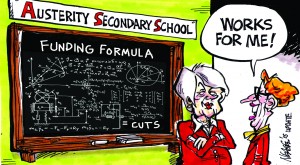The Defunding of Public Education
 In a comprehensive report on Ontario’s education funding for ETFO this month economist Hugh Mackenzie has produced a revealing and very readable testament to the critical importance of the Campaign for Public Education founded in Toronto in 2002. “September 22, 2017 marks the 20th anniversary of the introduction of Bill 160, euphemistically entitled the Education Quality Improvement Act, 1997. By assuming complete control of the finances of all school boards in Ontario, the bill ended nearly two centuries of local initiative in and accountability for the delivery of elementary and secondary education. It did so by eliminating the right of local school boards to raise revenue from the local property tax base and requiring boards to operate within the limits of a funding formula established under provincial regulation.
In a comprehensive report on Ontario’s education funding for ETFO this month economist Hugh Mackenzie has produced a revealing and very readable testament to the critical importance of the Campaign for Public Education founded in Toronto in 2002. “September 22, 2017 marks the 20th anniversary of the introduction of Bill 160, euphemistically entitled the Education Quality Improvement Act, 1997. By assuming complete control of the finances of all school boards in Ontario, the bill ended nearly two centuries of local initiative in and accountability for the delivery of elementary and secondary education. It did so by eliminating the right of local school boards to raise revenue from the local property tax base and requiring boards to operate within the limits of a funding formula established under provincial regulation.
Despite its title and the language of fairness and equity that peppered the government’s statements in support of the bill, its overriding purposes were to reduce overall spending on elementary education and transfer resources from “wealthy” large urban school boards to other less “wealthy” boards, most notably rural and remote as well as Catholic boards.
On day one, the formula was designed to reduce education operating spending, on an enrolment-and inflation-adjusted basis, by $833 million below its provincial total in 1997. By 2002-03, on an enrolment-and inflation-adjusted basis, funding had dropped to a level $1.7 billion below its pre-formula base and $913 million below its 1998-99 level.
Key areas affected by funding cuts
The impact of the reduction in funding was distributed throughout the system:
Because the formula provided less funding than boards needed to employ the teachers they were legally required to employ to meet basic class size standards, school boards diverted funding from programs intended to support students from immigrant families and students at risk.
Because the formula provided less funding for special education than boards had been spending prior to its introduction, boards were faced with significant unmet needs for special education services.
Because the formula provided funding for school operations well below the 1997 actual costs for boards serving a majority of the students in the province, deferred maintenance resulted in a marked deterioration in the physical quality of school facilities.
Because the formula was driven entirely by “classroom spending,” art and music education and library services were cut and, in some schools and boards, eliminated.
“By school year 2001-02 – only the fourth full year of the formula’s operation – the system had deteriorated to the point where the Progressive Conservative government appointed an independent task force to review the formula. Mordechai Rozanski, former president of the University of Guelph, headed the task force. Its 2002 report recommended an immediate increase in funding of $1.7 billion a year. It also drew attention to a $5.6 billion maintenance backlog and recommended additional funding to address that need.
In addition to his significant financial recommendations, Rozanski went beyond his mandate to highlight the negative consequences of the formula’s fixation with uniformity and its inadequate funding for special education, programming for students at risk and support for students whose first language is neither English nor French.
“Funding changes under the Liberal government In some respects, the election of a Liberal government in the fall of 2003 changed the terms of the education debate. The focus of government policy shifted from funding cuts to the implementation of election promises to improve the system. In the elementary system, the new government responded to pressure from the Elementary Teachers’ Federation of Ontario (ETFO) by reducing primary class sizes in its first term and introducing full-day Kindergarten in its second.
“A renewed commitment to collective bargaining also had a positive impact. In the mid-2000s, teachers’ salaries and benefits made up some of the ground lost in the 1990s. In addition, through collective bargaining, ETFO made gains in funding for preparation time that enabled the hiring of more specialist teachers in art, music, drama and physical education.1
Despite these changes, and the shift in tone that accompanied them, the government made a political choice to ignore most of the fundamental issues that had plagued the new funding system right from the beginning. It responded to the gap between funding and identified needs for special education by breaking the link between them and capping funding overall. It ignored recommendations for expanded English as a second language (ESL) programming. It dealt with the underfunding of teachers’ salaries by diverting funding from students at risk and eliminating funding intended to support local priorities. It provided funding for school renewal but left untouched the inadequate funding for operations and maintenance that had created the maintenance backlog in the first place.
“As a result, those fundamental issues persist. ” Read full report here


